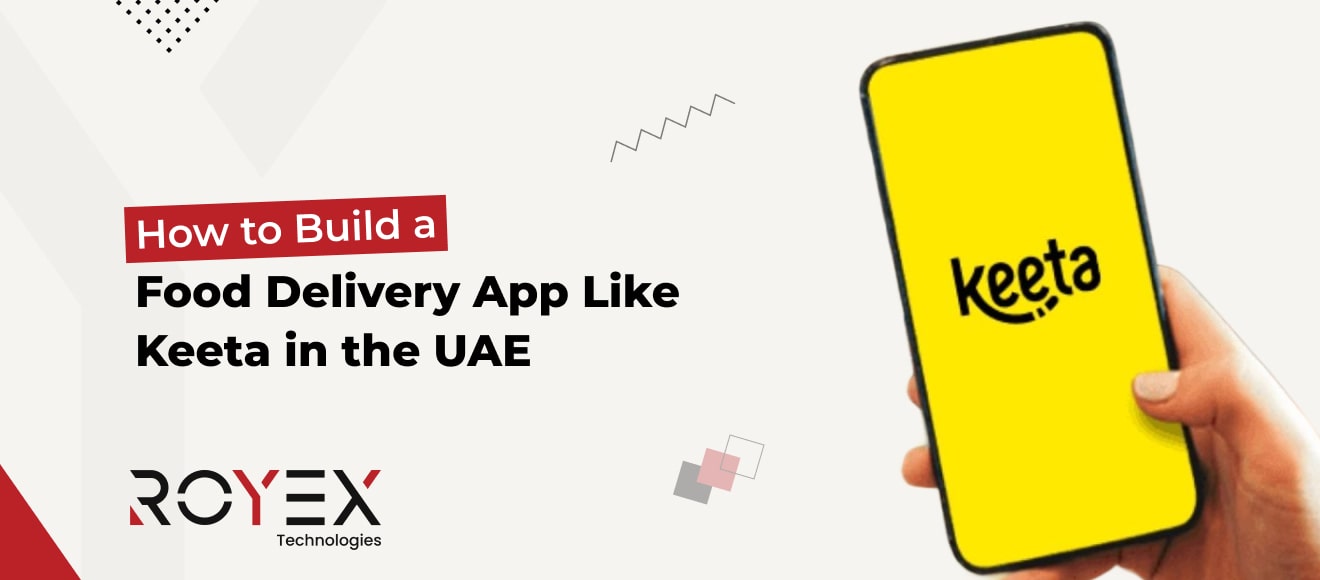
How to Build a Food Delivery App Like Keeta in the UAE
The food delivery industry in the UAE has grown rapidly in recent years. With fast-paced lifestyles, widespread smartphone usage, and increasing demand for convenience, residents are increasingly relying on mobile apps for their daily meals. Platforms like Keeta have emerged as market leaders, offering seamless restaurant discovery, fast delivery, and user-friendly experiences.
For entrepreneurs looking to capture a share of this booming market, building a food delivery app like Keeta requires more than just coding. Success depends on understanding the market, creating a scalable platform, and executing a strategy that balances customer acquisition with operational efficiency.
This guide provides UAE entrepreneurs with a comprehensive roadmap to build a competitive food delivery app, from understanding Keeta’s business model to defining core features, planning technical architecture, developing the app, and ensuring post-launch growth.
Understanding Keeta’s Business Model and Success
Before building a food delivery app, it’s important to analyze the business model of successful platforms like Keeta. Backed by Meituan, Keeta has expanded to multiple regions including Saudi Arabia, Qatar, and Brazil. It offers a wide selection of restaurants, real-time order tracking, loyalty programs, and promotional discounts, creating a seamless experience for both customers and restaurant partners.
Key revenue streams for a platform like Keeta include:
- Commission from restaurant orders
- Delivery fees charged to customers
- Subscription-based premium memberships
- Advertising and promotional campaigns
The app’s core functionality revolves around three main actors: customers, restaurants, and delivery agents, supported by a comprehensive admin panel.
Customer activities:
- Browse restaurants by location or cuisine
- Place orders and make payments
- Track deliveries in real-time
- Rate and review restaurants
Restaurant activities:
- Manage menus and prices
- Accept or reject orders
- Prepare meals and track delivery status
- Access analytics and manage promotions
Delivery agent activities:
- Accept delivery tasks
- Navigate to restaurant and customer locations
- Update order statuses
- Track earnings and incentives
While Keeta provides a proven model, UAE entrepreneurs should be aware of market-specific challenges:
- High competition from established players
- Logistics complexities related to fleet management
- Customer retention after initial promotions
- Regulatory compliance with UAE food safety standards and delivery licenses
Conducting Market Research for a UAE Food Delivery App
Thorough market research is a critical first step. The UAE presents a unique environment for food delivery services, with high urban density in cities like Dubai and Abu Dhabi, a multicultural population, and tech-savvy users.
Steps for effective market research include:
- Identify target audience: Young professionals, office workers, and families who prioritize convenience
- Analyze competitors: Study Talabat, Deliveroo, Zomato, and local startups for service gaps
- Validate the idea: Conduct surveys, interviews, or focus groups to understand user preferences and price sensitivity
- Define pricing strategy: Offer competitive delivery fees, loyalty programs, and subscription models
- Ensure legal compliance: Register the business, verify partner restaurants comply with health regulations, and obtain delivery licenses
Essential Features for a Food Delivery App Like Keeta
Building a food delivery app involves creating multiple interconnected platforms: the customer app, restaurant app, delivery agent app, and a robust admin panel.
Customer App Features:
- Easy registration and login (email, phone, or social login)
- Browse restaurants by location or cuisine
- Menu selection with item customization
- Cart management and checkout
- Multiple payment options (cards, Apple Pay, STC Pay, cash on delivery)
- Real-time order tracking and notifications
- Ratings, reviews, and feedback
- Loyalty programs, offers, and promotions
Restaurant App Features:
- Onboarding and profile setup
- Menu management (add/update items, categories, prices)
- Order management (accept/reject, preparation tracking)
- Delivery tracking for assigned orders
- Reports and analytics dashboards
- Promotions and marketing tools
Delivery Agent App Features:
- Registration and verification
- Delivery task acceptance and navigation
- Real-time location updates
- Status updates (pickup, in-progress, delivered)
- Earnings dashboard and incentives
Admin Panel Features:
- Manage customers, restaurants, and delivery agents
- Monitor orders and delivery performance
- Create and manage promotions and discounts
- Process payments and track revenue
- Access reporting dashboards and analytics
Designing a Scalable Technical Architecture
To succeed in UAE cities like Dubai and Abu Dhabi, your app must be scalable, secure, and reliable.
Platform selection:
- iOS and Android (native or cross-platform with Flutter/React Native)
- Cloud-based backend (AWS, Google Cloud, Azure)
- Databases: relational (PostgreSQL/MySQL) and NoSQL (MongoDB)
Key integrations:
- Payment gateways: Stripe, PayTabs, Network International
- Maps and routing: Google Maps, Here Maps
- Notifications and messaging: Firebase, Twilio
- Analytics: Firebase Analytics, Mixpanel
Security and compliance best practices:
- SSL encryption for data in transit
- Secure payment processing
- Compliance with UAE data protection regulations
- Regular security audits and updates
Creating an Intuitive User Experience
User experience is a key differentiator in food delivery apps.
UI/UX considerations:
- Smooth onboarding process with minimal steps
- Clear menu layouts and categories
- Real-time tracking for deliveries
- Push notifications to keep users engaged
- Accessibility features for all users
A well-designed user interface ensures customers enjoy a seamless ordering experience, increasing the likelihood of repeat orders and positive reviews.
Development Strategy for a Food Delivery App
A phased development strategy reduces risk and ensures timely delivery.
Development roadmap:
- MVP (Minimum Viable Product): Core features like restaurant browsing, order placement, payment, and tracking
- Beta launch: Test with limited users and gather feedback
- Full launch: Add loyalty programs, advanced analytics, and third-party integrations
Recommended team structure:
- Product manager
- UI/UX designer
- iOS & Android developers
- Backend developers
- QA testers
- Marketing and customer support
Timeline: Typically 4–6 months for UAE-based MVP, accounting for local payment integration, regulatory compliance, and logistics coordination.
Growth Strategies and Operational Excellence
Post-launch success depends on marketing, customer engagement, and operational efficiency.
Growth strategies:
- Digital marketing (Google Ads, social media campaigns)
- Influencer collaborations
- Referral programs and loyalty rewards
- Promotions and seasonal offers
Operational best practices:
- Monitor delivery performance regularly
- Manage fleet operations efficiently
- Ensure partner restaurants maintain high quality
- Gradually expand to additional UAE cities
- Optimize delivery routes using analytics
Cost to Develop a Food Delivery App Like Keeta
The development cost for building a food delivery app like Keeta in the UAE typically ranges from AED 45,000 to AED 80,000. This estimate covers:
- MVP (Minimum Viable Product) development: Core features such as restaurant browsing, menu selection, cart and checkout, multiple payment options, real-time delivery tracking, and admin panel functionality.
- iOS and Android app development: Either native or cross-platform frameworks like Flutter or React Native.
- Backend and database setup: Cloud infrastructure, APIs, and database configurations to handle orders, users, and analytics.
- Integration of essential tools: Payment gateways, maps and navigation, notifications, and analytics services.
This cost ensures a fully functional, scalable, and secure app ready for launch in the UAE market.
Common Challenges and How to Overcome Them
Launching a food delivery app comes with several challenges:
Potential pitfalls:
- Overbuilding the MVP without validation
- Ignoring UAE regulations and licensing requirements
- Inefficient delivery and fleet management
- Poor customer support leading to negative reviews
Mitigation strategies:
- Start with a lean MVP and validate the market
- Iterate based on user feedback
- Invest in efficient operations and customer support
- Maintain regulatory compliance
Frequently Asked Questions (FAQ)
Q1: How much does it cost to build a food delivery app like Keeta in the UAE?
A: The development cost for an MVP typically ranges between 45,000 and 80,000 AED. This includes building the customer, restaurant, and delivery apps, backend setup, integrations (payments, maps, notifications), and the admin panel.
Q2: How long does it take to develop a food delivery app?
A: For a UAE-based MVP, development generally takes 4–6 months, including backend setup, mobile app development, integration with payment gateways, and regulatory compliance.
Q3: What are the must-have features for a food delivery app?
A: Essential features include restaurant browsing, menu management, cart and checkout, multiple payment options, real-time delivery tracking, loyalty programs, and admin analytics dashboards.
Q4: How can I attract users in the UAE market?
A: Digital marketing campaigns, social media promotions, referral programs, influencer collaborations, and loyalty rewards are effective ways to acquire and retain users.
Q5: What are common challenges when launching a food delivery app?
A: Challenges include high competition, delivery logistics, customer retention, and regulatory compliance. Mitigation involves market validation, phased launches, operational efficiency, and strong customer support.
Start Building Your Food Delivery App with Royex
At Royex, we help entrepreneurs develop scalable, reliable, and feature-rich mobile apps tailored to the UAE market. From concept to launch, our team ensures your food delivery platform delivers exceptional user experiences while maintaining operational efficiency.
Established in 2013, Royex Technologies is a leading app development company in Dubai, that provides innovative solutions for small, medium, and large-scale companies. We specialize in responsive web development, mobile app development, CRM integration, AI solutions for website & mobile applications, and many more. Our extensive experience in mobile app development will help you to take your business to a high level.
Check our portfolio to see our previous works. Contact us via email at info@royex.net or call us at +971566027916. To get started with us.





